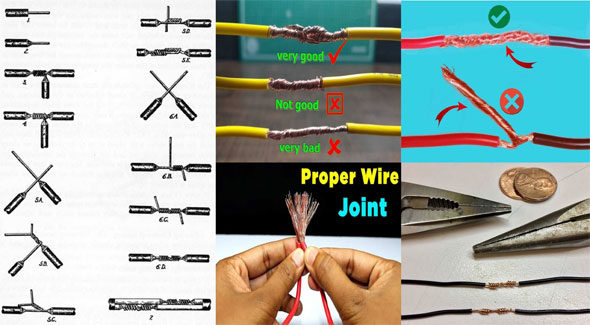Types of Cable Joints
- Concrete Cost Estimator
- Concrete Continuous Footing
- Landscape Bidding and Estimating
- Construction Cost Estimating
- Concrete and steel cost estimation
- Construction Cost Estimate Breakdown
- Construction Estimating Worksheet
- Home Construction Cost Estimate
- Estimate Pricing Sheet
- Sheet for General Contractor
- Construction Cost Estimate
- Labor Materials Cost Estimator
- Masonry Estimating Sheet
- Sheet for Building Contractor
- Construction Schedule Bar chart
- General Cost Estimator Sheet
- General Construction Estimate
- Building and Road Estimating Sheet
- Detailed expense estimates
- Door and Window Takeoff Sheet
- General Construction Cost Estimating Sheet

Both electrical joints and terminations are necessary for the desired electrical connection together with the mechanical support, and physical safety of the cable.
Depending on the function, type of cable and construction materials, several types of joints & terminations are found. The design is made based on the voltage and the current passing through the cable and the operational environment.
Electrical power cable terminations: The electrical cable termination means the physical and electrical connection of a cable which are attached with another cable, or with the terminal of the equipment. The cable terminations are mainly designed to allow the physical and electrical interconnecting of two cable ends, or a cable end and a terminal on the equipment.
The electrical connection requirements are connected with the voltage drop, current transmission strength, consistency of the materials, etc. The physical requirements pertain to the environmental protection and mechanical security.
Different processes are applied to terminate the cables as per the type of cable, type of connector and application.
The most recognized types of terminations range from crimp connection, soldered connection, compression termination, and wire-wrapping connection, direct connection, loop or eye connection. The types are based on the following types of the factors:
1. Outdoor or indoor use
2. Voltage
3. Current
4. Overhead, or underground
5. Type of Connector on the equipment where the cable are attached.
Electrical power cable joints: The purpose of the cable joints are to join low, medium or high voltage cables.
Also Read: Download Stack Takeoff and Estimating Software For Electrical Contractors
The type of cable joint sizes, shapes and configurations are different on the basis of the voltage, structure, insulation and the number of cores of the cable to be connected.
The joints are used for electrical insulation along with mechanical protection and strength. The electrical connection are developed in different ways. The mechanical connectors, soldering are also utilized.
Voltage: The joints are aimed at low, medium or high voltages and the capacity of the joint should be matched with that of the cable to avoid breakdown of a low power cable joint when susceptible to high current.
Structure: The cable joints are created in accordance with how the cables are attached. The simple joints like the straight through connectors are utilized to join two power cables at one point whereas the other more advanced branch connectors are utilized to adjust a cable branching off the main line or various cables approaching one joint to build one main cable.
Cores: The cable joints should contain the identical number of cores to those of the cables to be connected.
Insulation: Several cable insulations are found on the basis of the utilization of the cable and the cable joint should support the cable insulation.
To retain the insulation of the jointed cables, different types of insulation methods should be used which can either be heat or cold shrinkable insulation, r molded type of insulation, or application of tape.
Types of electrical power cable joints: The following types of joints are mostly found; these vary from mechanical arrangement and where they are applied. Though, some manufacturers may offer custom designs to match unique customer requirements.
• Straight through joints
• Branch which can be a T or Y joint
• Pot ends
• Indoor/Outdoor terminations

- Application of concrete calculator
- Roofing Calculator can streamline the roof estimating process
- House construction cost calculator
- Engineering column design excel spreadsheet
- Material Estimating Sheet with Excel
- Materials List and Cost Estimate Worksheet
- Concrete Slab Estimating Calculator Sheet
- Common types of foundations for buildings
- Online calculation of construction materials
- Estimating with Excel for the Small Contractor
- Concrete Beam Design Spreadsheet
- Virtual Construction Management app for construction
- Autodesk’s Project Skyscraper
- Reed Construction’s Reed Insight
- Manage your construction project documentation
- Costimator, the popular cost estimating software
- On Center Software for construction professionals
- Free Construction Estimating Software
- Plumbing Calc Pro
- Cost Estimate Worksheet
- HVAC Piping Quantity Takeoff Worksheet
- Construction Estimating Software Sheet
- Estimate Cost Templates
- Construction Punch List
- Construction cost estimating template consisting estimating basic
- Gantt Chart Template for Excel
- Download Civil Engineering Spreadsheets with Verification
- The Building Advisor Estimating and Budgeting Worksheet
- Spreadsheet for design of concrete bridge
- Construction Estimating Software Free








